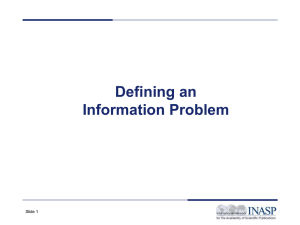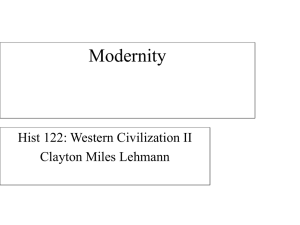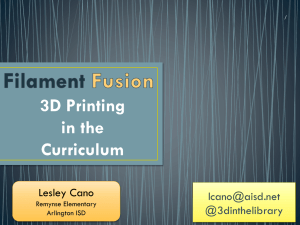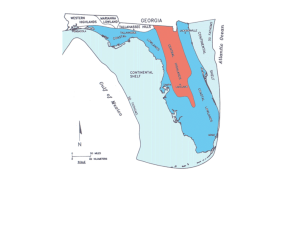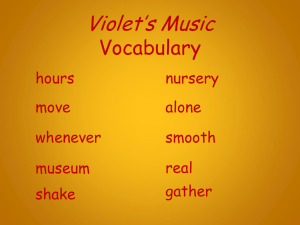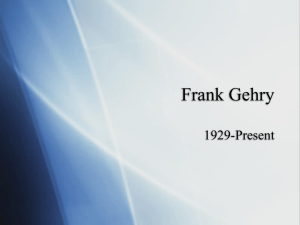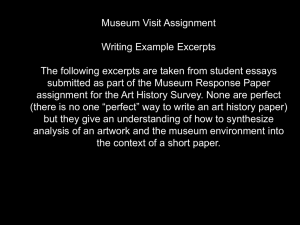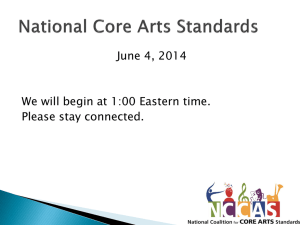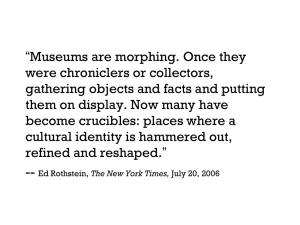The ASE Process Model: An Evidence
advertisement
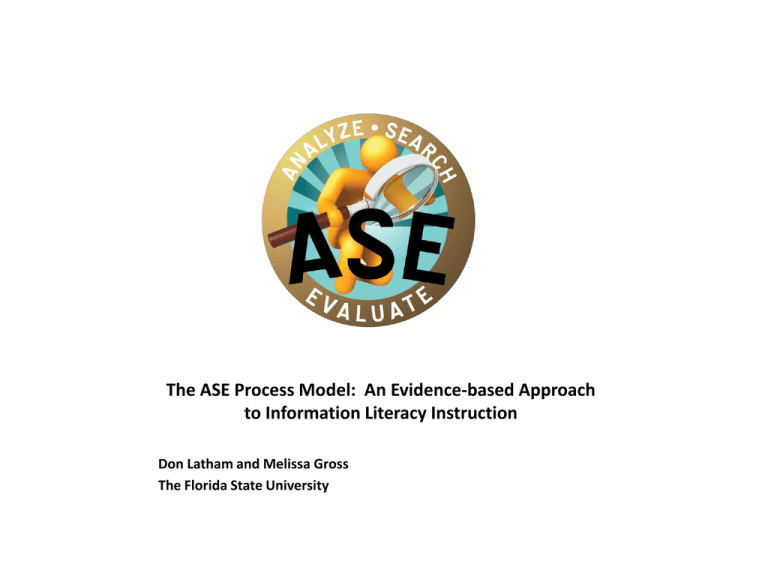
The ASE Process Model: An Evidence-based Approach to Information Literacy Instruction Don Latham and Melissa Gross The Florida State University Attaining Information Literacy Project • IMLS-funded, three-year collaborative project focusing on IL skills among first-year community college students • Partners: FSU and two Florida community colleges • Purpose: to identify students with below-proficient IL skills, gather data about their conceptions of and experiences with IL, and develop an IL intervention that will address their needs. 2 Innovating IL Instruction: Guiding Principles 1. 2. 3. 4. Use an evidence-based approach Focus on issues of perception Develop learner-centered instruction Develop reality-based instruction 3 1. Use an evidence-based approach • Information Literacy Test (JMU, n.d.) was administered in order to identify students with below-proficient IL skills. • Brief surveys were administered to collect demographic information, IL training history, and self-perceptions of ability in this domain. • Interviews were conducted with below-proficient students in order to identify their perceptions of IL and their own IL skills. • Focus groups were conducted with below-proficient students in order to identify their experiences with and preferences related to instruction. • Goals and criteria for instruction were developed. • Instruction was developed and pilot tested through an iterative process. 4 2. Focus on issues of perception • Students’ perceptions of IL – Relational model of IL (Bruce, 1997) – The students in our study did not think of IL as a discrete set of skills (Gross & Latham, 2009, in press). • Students’ perceptions of their own IL skills – Dunning-Kruger Effect and IL (Kruger & Dunning, 1999; Gross & Latham, 2007) – The below-proficient students in our study greatly overestimated their performance on the ILT. – When asked about their IL skills, they described them as “good” or “above average.” 5 3. Develop learner-centered instruction • Use the Informed Learning Approach (Bruce, 2008), which emphasizes learner experiences and perceptions and the need for a personal relevance framework. – Focus on self-generated rather than imposed (Gross, 1995) information seeking. – Focus on web rather than database searching (in other words, begin with the familiar). – Provide an incentive (in our case, payment; but other incentives could include making instruction required and/or offering college credit). 6 Develop learner-centered instruction (cont.) • Instructional design based on data collected from students. – – – – – – – Use a combination of demonstration and hands-on practice. Provide face-to-face rather than online instruction. Keep class size relatively small. Have students work in pairs. Provide ample opportunities for questions and feedback. Provide handouts (takeaways). Encourage self-reflection through pre- and post-surveys; encourage students to think about what they have learned. 7 4. Develop reality-based instruction • We recognized that IL cannot be achieved in a one-hour session. • Yet this is often the limit imposed on librarians and students. • We wanted to develop a flexible instructional model that could be – Used as a standalone module – adapted to a variety of settings and contentspecific goals. 8 Research Goals 1. Change learners’ conception of skills required to find, evaluate, and use information. 2. Change learners’ conception of their personal ability to find, evaluate, and use information. 3. Teach one skill that learners can readily use that will improve both self-generated and imposed information task outcomes. 9 Instructional Goals By the end of the workshop participants should be able to: 1. List the three steps of the information skills process. 2. Use keywords to search for information. 3. Evaluate internet search results. 4. Develop reality-based instruction • We recognized that IL cannot be achieved in a one-hour session. • Yet this is often the limit imposed on librarians and students. • We wanted to develop a flexible instructional model that could be – Used as a standalone module – adapted to a variety of settings and contentspecific goals. 11 4. Develop reality-based instruction • We recognized that IL cannot be achieved in a one-hour session. • Yet this is often the limit imposed on librarians and students. • We wanted to develop a flexible instructional model that could be – Used as a standalone module – adapted to a variety of settings and contentspecific goals. 12 Iterative Design Process • Criteria for intervention were developed based on data collected from student interviews and focus groups. • Intervention (instruction) was designed and developed. • Feedback was solicited from our advisory group (four academic librarians from community and university libraries) • Formative evaluation was used; intervention was pilot tested: – With several students one on one – In small groups (3-4 students each) – In two pilots with a group of 12 students in one workshop and 7 in the other. – During a pilot of instructor training with a group of academic librarians • Modifications were made after each iteration. 13 Summative Evaluation • Intervention and control groups – 46 participants in each group – Pre and post intervention surveys focused on workshop content – Review of workshop materials – Pre and post ILT scores – Pre and post self estimates of skill • In-depth interviews with 30 workshop participants • Debriefing with workshop leader Intervention • • • • • • • • One hour workshop format Small groups Students work in pairs Interactive Internet Searching ASE model Focus on self-generated questions Includes structured worksheets and handouts Information Skills: How to Find the Information You Need Workshop structure • Session objectives – List three steps of the information process – Use keywords to search – Evaluate Internet search results • What’s on your mind? • ASE process model – Analyze – Search – evaluate • Reflection and wrap up • More information and help Keeping instruction relevant • Use of self generated questions • Focus on Internet searching • Hands-on work in pairs • Interactive. At each step – Worksheets – Reports to class – Feedback Analyze, Search, Evaluate 1. What do you want to find out? Analyze need. 2. How do you find the information? 3. Which information will you use? Search for information. Evaluate results. Analyze the kind of information you need. Search for information. Determine the best information to use. •What is the goal? •What information helps you reach your goal? •Key words •Synonyms •Truncation •Exact words phrases •Relevant •Credible •Current The ASE Process Model Analyze, Search , Evaluate How to Find the Information You Need ASE Process Model 1.Analyze the kind of information you need 2.Search for information using keywords 3.Evaluate search results in relation to your information need Project Funded by the Institute of Museum and Library Studies, National Leadership Grant LG-06-08-0049 Step 1: A is for Analyze • Example: What is happening in Tallahassee? • Analyze the kind of information you need. –What is the goal of the search? We want to find something to do with our friends to this weekend. –What questions do we want to answer? What kind of events are happening, where, what times, and how much does it cost? Project Funded by the Institute of Museum and Library Studies, National Leadership Grant LG-06-08-0049 Step 2: S is for Search • Example: What is happening in Tallahassee this weekend? • Using the internet, how will we search for the information we need? –Keywords –Truncation –Exact Words or Phrase Project Funded by the Institute of Museum and Library Studies, National Leadership Grant LG-06-08-0049 Keywords What are the main ideas in your topic? Use the main ideas as key words. •Example: What is happening in Tallahassee this weekend? •Keywords: Tallahassee, happening, weekend Consider using synonyms for key words. •Synonyms: Leon County, events, November 21 Project Funded by the Institute of Museum and Library Studies, National Leadership Grant LG-06-08-0049 Truncation • Get more results by using all forms of a word • (Note: this does not apply to all words. Example: sheep). –Write keywords that could have multiple forms with an asterisk (*) immediately following them • Example: • We decide we want musical events occurring on November 21 and all of December. –Tallahassee, music* event*, November 21, December* Project Funded by the Institute of Museum and Library Studies, National Leadership Grant LG-06-08-0049 Exact Words or Phrase • Get more specific results by using quotation marks around the phrase or words or use the advance search option on the search engine. • (Note: this is not useful for single words. Example: “girl”) • Example: • We hear about a country western singer bringing a new show to Tallahassee. • “Wide Open 2010: Jason Aldean” Project Funded by the Institute of Museum and Library Studies, National Leadership Grant LG-06-08-0049 Additional Search Tips • Advanced Search Tips –Exclude certain words –Specify domains or sites •Within a domain: .edu (or .org, .gov, etc.) •Within a site: youtube.com (or npr.org, etc.) –Date (how recent a page is) •Anytime or past day to past year • Check out the Advanced Search Tips –www.google.com Project Funded by the Institute of Museum and Library Studies, National Leadership Grant LG-06-08-0049 Summary • ASE Process Model –Analyze – Determine your goal and what information you need –Search – Use keyword search strategies –Evaluate – Determine if the information is •Relevant •Credible •Current Project Funded by the Institute of Museum and Library Studies, National Leadership Grant LG-06-08-0049 Using the ASE Model • Orientation and First Year Experience • As a stand alone workshop • Return to model in developing workshops on other topics – Academic databases – Library catalog – Searching social network sites – Using print resources All workshop materials will be made available on the project website. Includes instructor guide, PowerPoint slides, handouts, and assessment tools. ATTAINING INFORMATION LITERACY PROJECT HTTP://WWW.ATTAININFOLIT.ORG Acknowledgments We would like to thank: – IMLS for providing funding for the AIL Project. – Bonnie Armstrong for assisting with the instructional design. – The librarians at the participating community colleges. – Our graduate research assistants, Debi Carruth and Meredith Mills. – Our advisory board: Rebecca Bichel, Kenneth Burhanna, Sarah McDaniel, and Bianca Rodriguez. Latham & Gross / CAIS 2010 29 Thank you! Attaining Information Literacy Project http://www.attaininfolit.org Don Latham dlatham@fsu.edu Melissa Gross mgross@fsu.edu 30

